Clinical Microcurrent Stimulators : How They Work & What They Treat
Apr 7th 2025
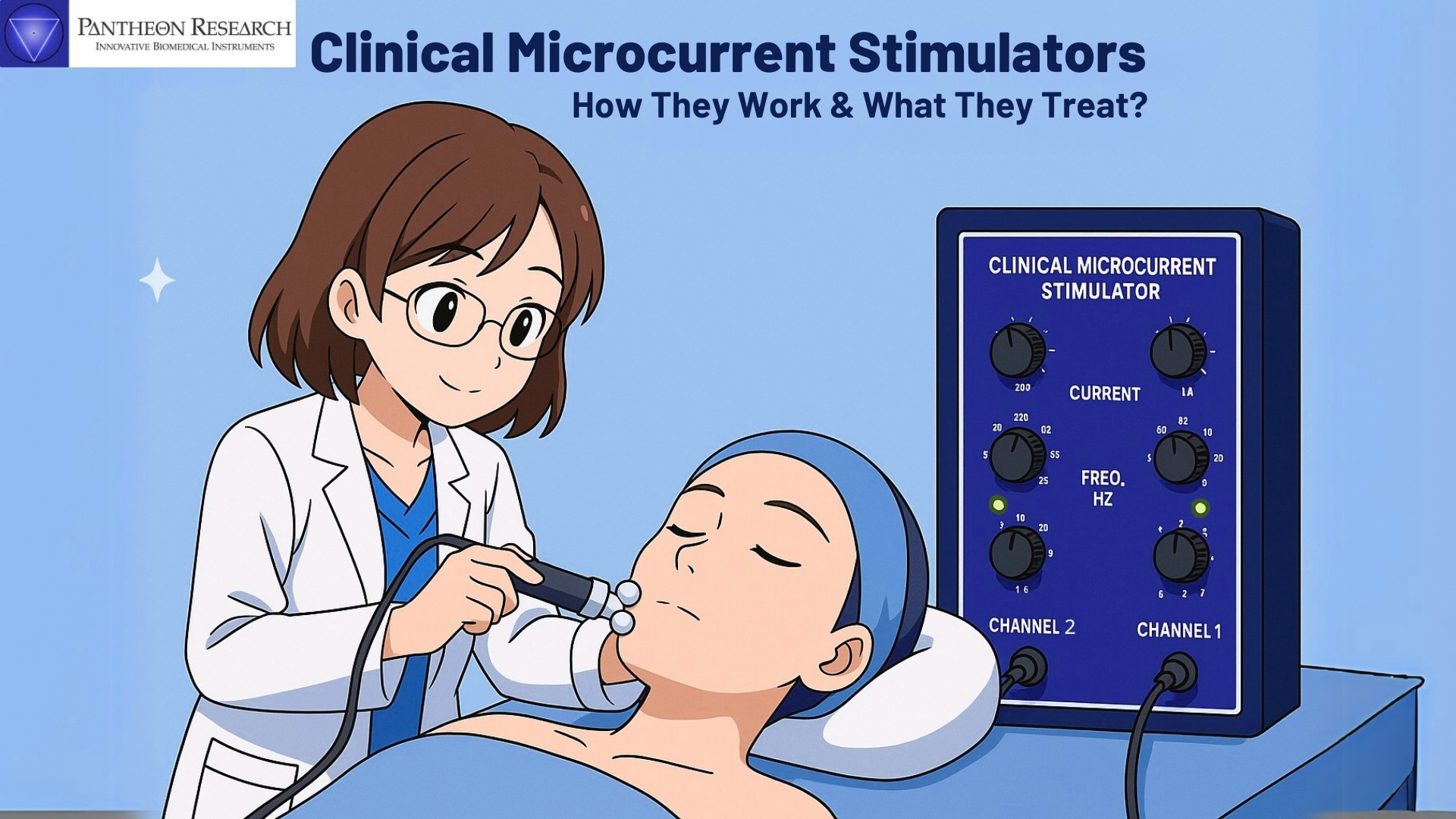
Introduction: The Rise of Microcurrent Therapy in Modern Clinical Practice
Microcurrent therapy has rapidly emerged as a powerful tool in modern clinical and aesthetic settings. Known for its non-invasive, sub-sensory electrical stimulation, microcurrent therapy is now widely used to address chronic pain, inflammation, facial toning, wound healing and tissue regeneration.
Microcurrent therapy uses ultra-low electrical stimulation designed to replicate the body’s internal bioelectrical activity at a cellular level. Unlike traditional electrotherapy methods like TENS or EMS, microcurrent works on a cellular level - promoting healing, improving circulation & enhancing ATP production without triggering strong sensory responses.
As demand grows for evidence-based, patient-friendly modalities across physiotherapy, dermatology, sports medicine & integrative clinics, microcurrent stimulators are earning their place as a next-generation electrotherapy solution.
In this article, we’ll break down:
- The science behind microcurrent technology
- How it works at the cellular and neurological level
- Key clinical benefits for your patients
- What to look for in a microcurrent stimulator
- How to integrate it safely and profitably into your practice, while staying aligned with current technology and patient care standards
What Are Clinical Microcurrent Stimulators?
Clinical microcurrent stimulators are specialized electrotherapy devices designed to deliver extremely low electrical currents, typically between 50 to 600 microamperes (µA) to specific areas of the body. These microcurrents mimic the body’s natural electrical activity, delivering sub-sensory stimulation through the device’s output channels.
Unlike electroacupuncture machines, which are designed to stimulate acupuncture points using external clip leads or non-contact connectors, microcurrent stimulators typically use surface electrodes or handheld probes. They are optimized for sub-sensory stimulation, meaning most treatments are painless and non-invasive. While both technologies offer therapeutic value, clinical microcurrent stimulators are particularly effective for applications involving cellular repair, facial aesthetics, nerve regulation & tissue regeneration.
Common Features of Clinical Microcurrent Devices:
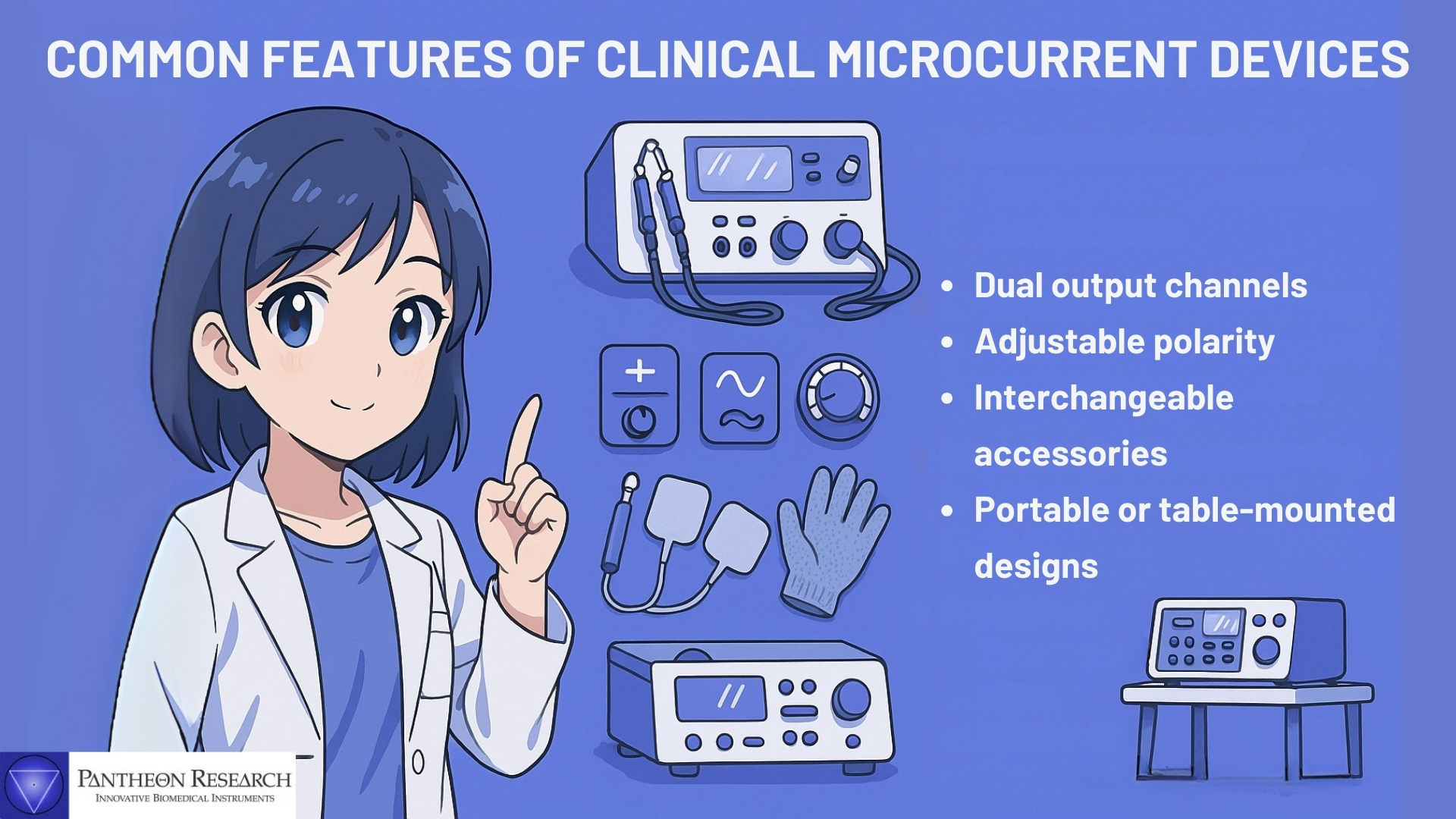
- Dual output channels for bilateral symmetry or multiple treatment zones
- Adjustable polarity, waveform presets, and frequency control for protocol customization
- Interchangeable accessories, including facial probes, TENS pads, and conductive gloves
- Portable or table-mounted designs, adaptable for various clinical environments
How Do Microcurrent Stimulators Work? (Scientific Explanation)
Microcurrent stimulators work by delivering ultra-low electrical currents, typically below 600 microamperes (µA) that interact directly with the body’s natural bioelectrical and cellular communication systems. These currents are designed to mimic the electrical signals produced by healthy human cells, particularly in areas affected by injury, inflammation, or functional disruption.
What makes microcurrent therapy unique is its sub-sensory nature, patients generally feel nothing during treatment yet the physiological impact at the cellular level is significant. Here's how it works:
ATP Production and Cellular Energy
One of the most well-documented mechanisms of microcurrent therapy is its ability to increase ATP (adenosine triphosphate) the essential energy molecule needed for healing and regeneration.

According to Cheng et al. (1982), microcurrent stimulation can increase ATP production by up to 500%, which in turn accelerates:
- Wound healing
- Tissue regeneration
- Fibroblast activity
- Muscle recovery and protein synthesis
This ATP surge triggers a cascade of cellular processes that support faster recovery—without the need for invasive procedures.
Electrical Signalling and Ion Exchange
Microcurrent therapy also influences ion exchange across cell membranes, a process critical for:
- Regulating inflammatory response
- Balancing cellular pH
- Enhancing nutrient absorption and waste elimination
By restoring electrical balance in damaged or inflamed tissues, microcurrent creates a more stable internal environment for healing especially in chronically compromised areas.
Polarity, Frequency & Waveform Modulation
Advanced microcurrent devices allow practitioners to customize:
- Polarity (positive, negative, or biphasic)
- Frequency (ranging from 0.5 Hz to 1500 Hz)
- Waveform type (square, sinusoidal, symmetrical biphasic, etc.)
This adaptability ensures the therapy can be fine-tuned based on tissue type and treatment goals. For example:
- Positive polarity may help reduce inflammation
- Negative polarity may promote cellular repair
- Frequency sweep modes prevent nerve accommodation
Devices like the 12c.Pro Advance Electro-Stimulator include features such as Pulse Width Modulation and the patented Pulse Width Sweep, allowing for more nuanced nerve fiber stimulation, improved variability and reduced treatment resistance over time.
Together, these mechanisms explain why microcurrent therapy is more than just superficial - it enables deep biological healing, supports long-term outcomes and offers unmatched precision in modern electrotherapy.
Microcurrent Settings and Clinical Applications Table
| Device Parameter | Setting Options | Common Use Cases / Treatment Goals |
| Polarity | • Positive • Negative • Biphasic |
✅ Positive: Reduces inflammation (acute injuries) ✅ Negative: Stimulates tissue repair (chronic injury, post-op) ✅ Biphasic: Balanced protocols or adaptive stimulation |
| Frequency | 0.5 Hz – 1500 Hz | ✅ Low (0.5–10 Hz): Endorphin release, chronic pain ✅ Mid (30–300 Hz): Muscle stimulation, circulation ✅ High (500–1500 Hz): Nerve stimulation, edema control |
| Waveform | Square, Sinusoidal, Symmetrical Biphasic | ✅ Square: Consistent output, muscle re-education ✅ Sinusoidal: Gentle, aesthetic/skin protocols ✅ Symmetrical Biphasic: Balanced nerve/muscle activation |
| Purse Width Sweep (Patented) |
Dynamic, automatically cycling pulse widths | ✅ Prevents tissue adaptation ✅ Enhances long-term treatment effectiveness ✅ Improves patient response to repeat sessions |
| Intensity (Current Level) |
50–600 μA (Sub-sensory range) | ✅ Subtle, cellular-level healing ✅ No nerve blocking or muscle fatigue ✅ Ideal for sensitive or post-surgical patients |
Key Clinical Benefits for Practitioners
While microcurrent therapy is often described as gentle and non-invasive, its therapeutic effects are anything but superficial. For practitioners, the science behind microcurrent translates into faster patient outcomes, expanded treatment capabilities and higher clinical effectiveness across a wide range of use cases.
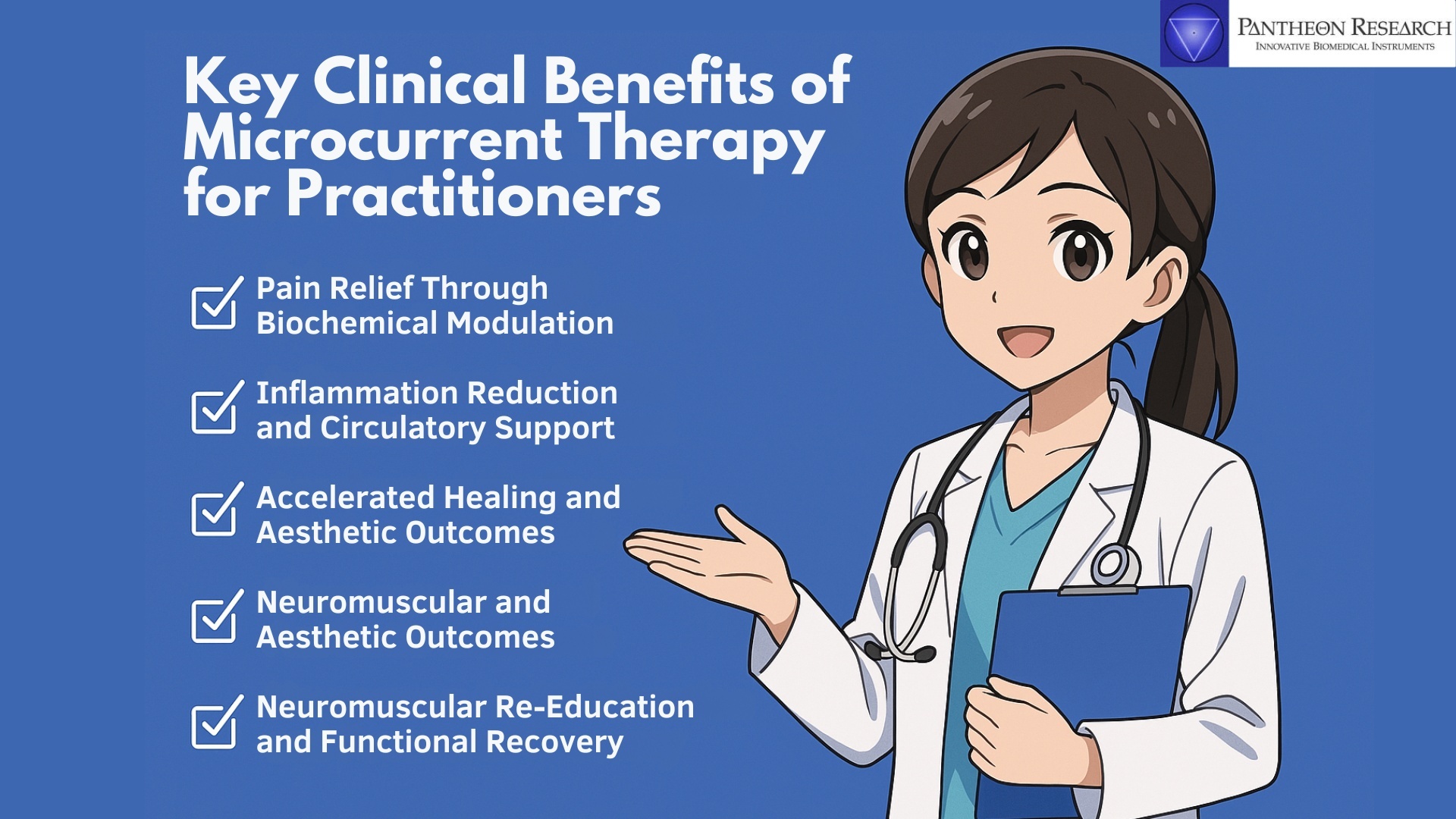
Here are the key evidence-based benefits practitioners can expect when integrating microcurrent therapy:
1. Pain Relief Through Biochemical Modulation
Unlike TENS, which blocks pain signals through sensory stimulation, microcurrent works below the sensory threshold, influencing endogenous biochemical processes. It promotes:
- Endorphin release
- Normalization of nerve signal transmission
- Reduced nociceptive activity
✅ Use Case: Chronic pain, post-operative recovery, trigger point therapy.
2. Inflammation Reduction and Circulatory Support
Microcurrent has been shown to modulate inflammatory markers (e.g., IL-6, TNF-α) while improving blood flow and lymphatic drainage. This contributes to:
- Faster post-injury or post-surgical recovery
- Reduced swelling and edema
- Improved mobility in musculoskeletal conditions
✅ Use Case: Sports medicine, joint dysfunction, orthopedic rehab.
3. Accelerated Healing and Tissue Regeneration
Through increased ATP production and protein synthesis, microcurrent supports:
- Collagen and elastin regeneration
- Enhanced fibroblast activity
- Faster wound closure and epithelialization
✅ Use Case: Scar therapy, post-surgical healing, pressure ulcers, tendon repair.
4. Facial Rejuvenation and Aesthetic Outcomes
Microcurrent can gently stimulate facial muscles, improve microcirculation, and increase skin tone—without downtime or needles. It's widely used in aesthetic protocols for:
- Lifting and contouring
- Acne scar softening
- Fine line reduction
✅ Use Case: Non-invasive anti-aging, post-acne treatment, dermal rejuvenation.
5. Neuromuscular Re-Education and Functional Recovery
Microcurrent helps retrain weak or atrophied muscles and improves neuromuscular communication without inducing fatigue. It supports:
- Motor coordination
- Proprioceptive response
- Muscle tone restoration
✅ Use Case: Bell’s palsy, TMJ dysfunction, facial paralysis, post-stroke rehab.
In short, microcurrent therapy empowers practitioners with a versatile, clinically validated modality that improves outcomes across pain management, rehabilitation & aesthetics without discomfort or downtime.
Why Clinics Are Embracing Microcurrent Devices – Operational and Business Advantages
While the clinical outcomes of microcurrent therapy are well-documented, many clinics adopt this technology for its operational and financial advantages. In today’s competitive healthcare environment, devices that offer efficiency, low risk & service scalability are critical for sustainable growth.

Here’s why microcurrent stimulators are becoming a go-to investment for modern practices:
1. Workflow Efficiency & Multitasking
Most microcurrent treatments are hands-free and require minimal setup, allowing clinicians to:
- Supervise multiple patients simultaneously
- Delegate sessions safely to trained assistants
- Streamline protocols without compromising care quality
✅ Result: More patients treated per hour, without adding staffing overhead.
2. Low-Risk, Non-Invasive Modality
Microcurrent therapy is sub-sensory, pain-free, and has no recovery time—ideal for:
- Post-surgical patients
- Seniors and those with sensitive skin
- Clinics focused on low-liability, patient-friendly solutions
No complex licensing or post-procedure protocols required.
3. Cross-Department Versatility
One microcurrent system can serve diverse departments:
- Physical therapy
- Aesthetics and facial rejuvenation
- Neurological rehab
- Sports medicine
✅ This reduces equipment redundancy and simplifies team training across service lines.
4. Easy Staff Onboarding & Clinical Integration
Modern systems are designed with intuitive controls and built-in safety features, making onboarding fast and consistent. Many also include access to CEU-accredited training programs, which help practices integrate microcurrent protocols confidently and safely into everyday care. Clinics can further expand team expertise through Microcurrent Therapy Training which offers structured, in-depth courses for both clinical and aesthetic professionals.
5. High ROI and Flexible Monetization
With low consumable costs, reusable accessories, and applications spanning both therapeutic and cosmetic care, microcurrent therapy offers excellent return on investment. Clinics can generate revenue through:
- Single-session protocols
- Premium aesthetic packages
- Ongoing care plans for chronic or aging-related conditions
In short, microcurrent therapy isn’t just a clinical tool - it’s a strategic asset. Scalable, efficient, and adaptable across specialties, it aligns with the operational demands of modern healthcare and wellness environments.
How to Choose the Right Microcurrent Stimulator for Your Practice?
Not all microcurrent machines are created equal—and choosing the right one can significantly impact your results, workflow, and return on investment. Whether you're a physical therapist, acupuncturist, aesthetician, or integrative health provider, your ideal device should meet clinical, technical and operational needs.
Here’s what to look for when selecting a professional-grade microcurrent stimulator:
- Fully independent output channels for bilateral or multi-site treatments
- Wide frequency range (ideally 0.5–1500 Hz) to support diverse protocols
- Adjustable polarity (positive, negative, or biphasic) for tailored stimulation
- Sub-sensory microampere output, ideally up to 1000 µA, for cellular-level treatment
- Accessory compatibility, such as facial probes and TENS pads
- Battery-powered and portable design for mobile setups or space-constrained clinics
Product Example: Pantheon’s Clinical Microcurrent Solution
A top tier option is the Clinical Microcurrent Stimulators available from Pantheon Research, engineered specifically for professional use across therapeutic and aesthetic applications.
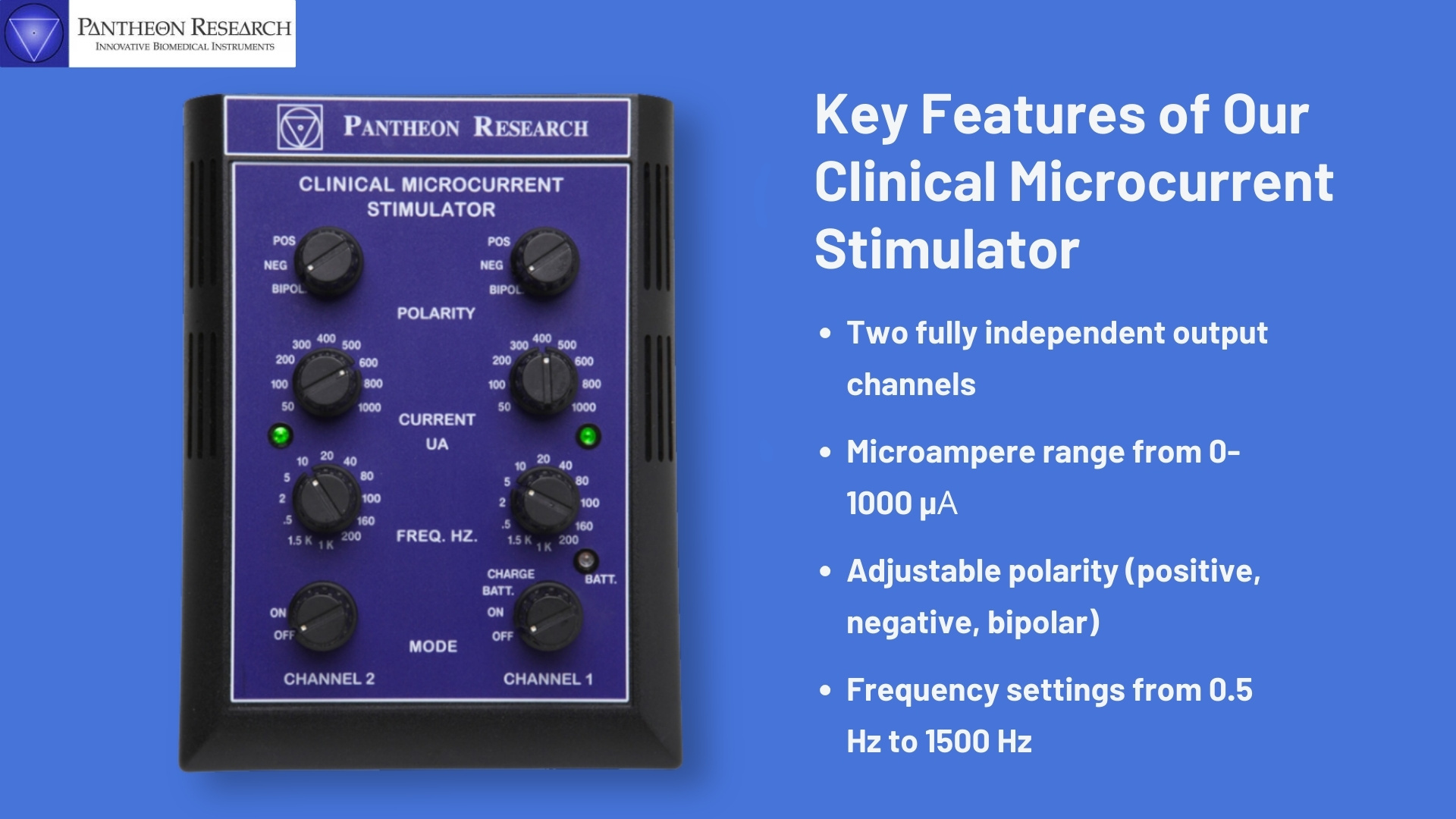
Key features include:
- Two fully independent output channels
- Microampere range from 0–1000 µA
- Adjustable polarity (positive, negative, bipolar)
- Frequency settings from 0.5 Hz to 1500 Hz
- Continuous operation mode with built-in battery tester
- Rechargeable 12V Nickel-metal Hydride battery
Included accessories cover dual probes, TENS lead wires & reusable pads, expandable with extra leads and replacement parts as needed.
While not intended for needle-based electroacupuncture, this system is ideal for pain management, facial rejuvenation, muscle recovery & soft tissue healing.
Each purchase also comes with a complimentary 12 CEU Distance Course on Microcurrent for Facial Rejuvenation (a $149.99 value), empowering practitioners to integrate the device with clinical confidence and proven protocols.
Clinics that offer both microcurrent and electroacupuncture treatments may benefit from investing in one of the best electro acupuncture stimulators to support needle-based protocols and point-specific neuromodulation.
Patient Safety & Side Effects: What You Should Know?
While microcurrent therapy is considered one of the safest forms of electrotherapy, it's essential for practitioners to apply it with care. Responsible use through proper screening, patient education, and adherence to contraindications - ensures optimal outcomes and minimizes potential risks.
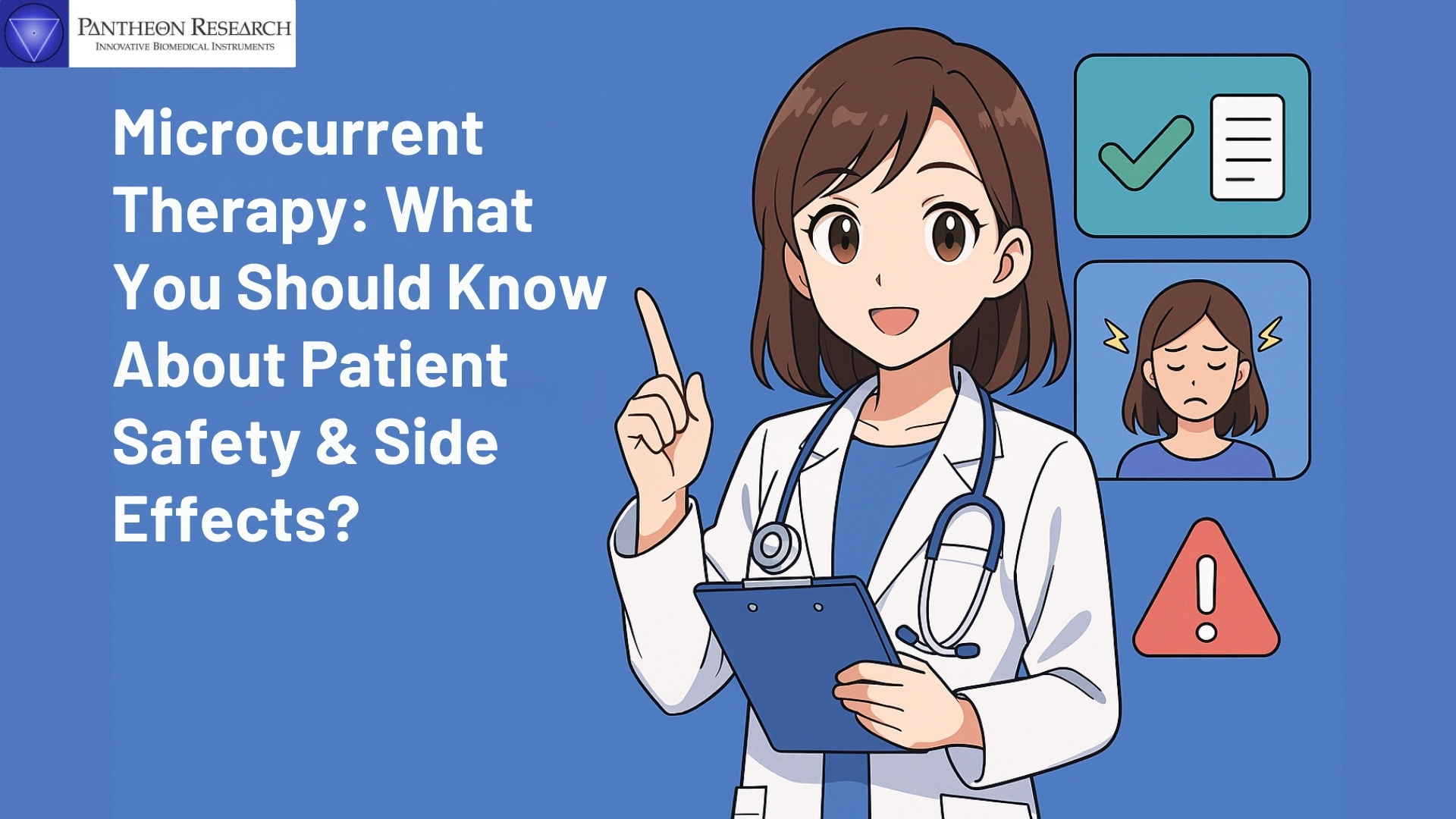
✅ When Not to Use Microcurrent Therapy?
Microcurrent stimulation is contraindicated in the following cases:
- Patients with pacemakers or implanted electronic devices
- Pregnancy, especially over the abdomen or lower back
- Individuals with epilepsy or a history of seizures
- Active cancerous lesions
- Areas with unexplained swelling, infection, or undiagnosed symptoms
In these cases, practitioners should either seek physician clearance or explore alternative modalities.
⚠️ Minor Side Effects to Be Aware Of
Microcurrent therapy is sub-sensory, so most patients feel little to no sensation during treatment. However, on rare occasions, you may observe:
- Light muscle twitching (especially near motor points)
- Mild skin irritation or redness (typically from electrode pads, not the current itself)
- Temporary Dizziness or fatigue if hydration is low or treatment is too long
To mitigate these risks:
- Ensure adequate hydration before and after sessions
- Limit early sessions to 15–20 minutes for new patients
- Always use FDA-cleared equipment with built-in safety features (like no-shock start and lead testers)
Built-in Safety Features in Professional Devices
Modern clinical-grade devices are built with safety mechanisms that enhance both practitioner control and patient comfort:
- No-shock start: Ensures current delivery only begins after settings are confirmed
- Battery level indicators: Prevent voltage drops mid-treatment
- Clip lead testers: Confirm full circuit continuity before stimulation begins
- Auto shut-off or timer functions: Prevent overstimulation or unattended use
These safeguards make microcurrent an excellent choice for daily clinical use, even in sensitive populations like seniors, post-op patients, or those with chronic conditions.
✅ Bottom Line:
When used appropriately with the right equipment and patient screening, microcurrent therapy is one of the safest and most scalable treatment options available in modern clinical and aesthetic care.
Looking Ahead – The Future of Microcurrent Therapy in Smart Clinics
.As healthcare embraces smart technology, microcurrent systems are evolving toward greater personalization, automation, and data-driven care. Here’s what’s on the horizon:
- AI-Guided Protocol Optimization
Future systems may use machine learning to analyze patient responses and auto-adjust settings like frequency and waveform—delivering tailored results with less manual input.
- Remote Monitoring & Cloud Connectivity
Next-gen devices may feature cloud-based session logging, ideal for telehealth support, therapist coordination, and long-term outcome tracking.
- Integration with EMRs and Wearables
Microcurrent systems could sync with electronic records and biosensors (e.g., HRV, skin conductivity) to adapt treatments in real time.
- Home Use with Clinician-Approved Mobile Apps
Guided by mobile interfaces, patients may follow prescribed protocols from home, improving continuity and engagement between in-clinic sessions.
Conclusion: Microcurrent Therapy for the Modern Clinic
Microcurrent therapy bridges the gap between advanced science and everyday clinical application. With its ability to enhance ATP production, regulate inflammation, support tissue regeneration and deliver results without discomfort, it offers a powerful, evidence-based alternative to conventional electrotherapy.
As technology evolves, microcurrent systems are becoming more intelligent, efficient, and versatile - enabling clinics to offer personalized, scalable care across therapeutic and aesthetic disciplines.
Whether you're aiming to accelerate patient recovery, expand into non-invasive facial rejuvenation, or modernize your clinic’s treatment protocols, clinical microcurrent stimulators deliver the scientific precision and practice-ready performance to help you stay ahead.
Frequently Asked Questions (People Also Ask)
What does microcurrent therapy do?
Microcurrent therapy delivers ultra-low electrical currents (typically under 600 µA) that mimic the body’s natural cellular signals. These currents stimulate ATP production, enhance cellular repair, reduce inflammation, and support neuromuscular re-education. It’s commonly used in physical therapy, wound care, facial rejuvenation, and chronic pain management.
Is microcurrent therapy backed by science?
Yes. Microcurrent therapy is supported by numerous clinical studies. Research has demonstrated its effectiveness in increasing ATP production, reducing inflammation, and enhancing wound healing, making it a credible and evidence-based modality.
How often should a patient receive microcurrent treatment?
Treatment frequency depends on the individual’s condition and therapeutic goals.
- For general wellness or mild concerns: 1–2 sessions per week
- For intensive needs (e.g., chronic pain, post-op recovery, facial toning): 3–4 sessions per week initially
Frequency often decreases as the patient improves. Always consult with a qualified practitioner for a customized plan.
Does microcurrent therapy hurt?
No, microcurrent therapy is a sub-sensory treatment, meaning most patients feel little to no sensation during sessions. It works by delivering very low-level electrical currents that mimic the body's natural bioelectrical signals. The therapy is gentle, with no discomfort or pain. Some patients may experience light muscle twitching or mild redness, but these effects are temporary and not painful.
Is microcurrent safe for seniors or those with sensitive skin?
Yes, microcurrent is typically well-tolerated by seniors and individuals with sensitive skin. Its low-intensity approach makes it a safe option when applied correctly. However, it's important to consult a healthcare provider if the patient has specific conditions (e.g., pacemakers, active cancer, epilepsy).
